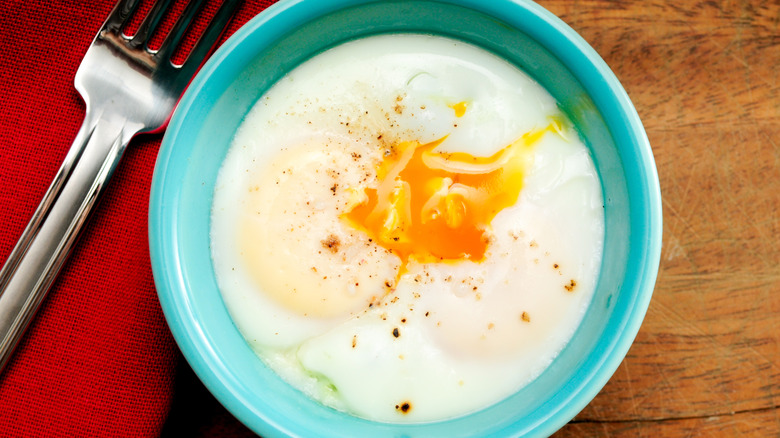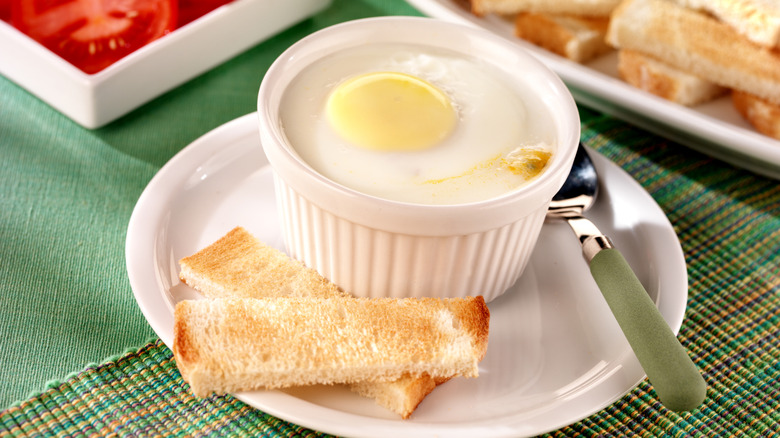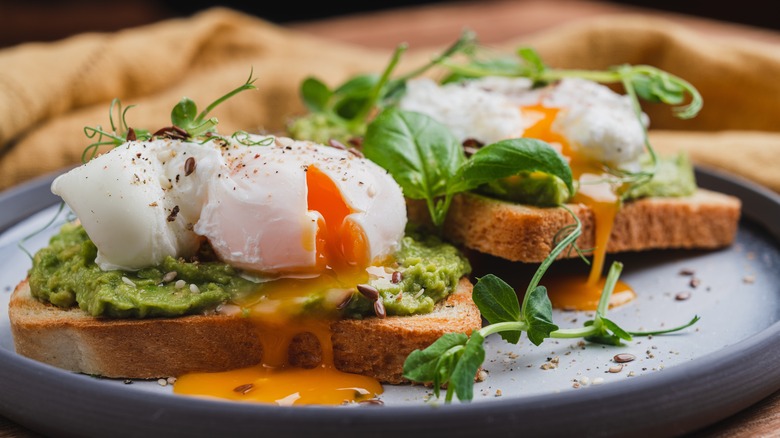Coddled Vs Poached Eggs: Here's What Sets Them Apart
Can you eat a different style of eggs every day for a year? If you get creative, it's very possible. Eggs are at home in breakfast, lunch, or dinner dishes, and they can be fried, boiled, or even microwaved — and that doesn't even begin to cover the recipes where they're baked, whisked, and whipped into the foods we love. With all the ways eggs can be prepared, it's easy to get some methods confused — especially poached and coddled eggs. Both styles are cooked with gentle heat, but they're not the same thing. The most important difference is that poached eggs are cooked directly in simmering water, while coddled eggs are cooked in a ramekin or another heat-safe dish in a water bath.
It shouldn't be too hard to tell the difference when these two dishes are served, however. Poached eggs, which are arguably more common on restaurant menus, are served either alone or on top of other foods — think bread, potatoes, or polenta. Coddled eggs, on the other hand, are served right in the ramekin, which makes a bit of a statement on the plate, and they often have extra ingredients right inside the bowl.
Coddled eggs
If you've never seen a coddled egg on a brunch menu, it's not your imagination. While coddling is a delicious way to gently cook eggs, it's not exactly conducive to short-order cooking. The most common process is to crack an egg into a greased ramekin, then simmer it on the stove — either covered or in containers with covers, like small Ball jars. You can also cook coddled eggs in a water bath in the oven at 350 degrees Fahrenheit. Coddling is, however, one of the gentlest ways to cook an egg, and the results are worth it. When done just right, coddled eggs have a very soft texture and glossy, satiny yolks.
There are some pluses and minuses to coddling. First of all, not everyone has a collection of ramekins on hand, and it's easy to forget them in the oven or on the stove unless you set a timer. However, you can make a whole batch in the oven or a large pot at the same time, which makes them ideal for serving a group. They also make quite a show as the centerpiece of a plate, and you can add extras like mushrooms, peppers, cheese, and meat right into the ramekin and cook everything together.
Coddled eggs are sometimes used in Caesar salad dressing to create a creamy texture. They're also very elegant served simply with some toast "soldiers," which are pieces of toast cut into sticks — perfect for dipping and stabbing into the soft yolk.
Poached eggs
If you had to choose between poached and coddled eggs based on time, poached eggs are the faster option. They are made by gently dropping whole cracked eggs into gently simmering acidulated water and cooking them for about three minutes, until the white sets and the yolk begins to harden. The goal is a firm white with a yolk that's still runny inside but stiff enough to stand up to a slotted spoon. The yolk is really the highlight of the dish, and many dishes like shakshuka and corned beef hash taste that much better with some soft, silky yolk mixed in.
Without a ramekin to keep everything contained, however, poached eggs are a bit more prone to common mistakes. Make sure that the poaching water isn't too hot or cold, and always add a teaspoon of white vinegar or lemon juice to the water to help the eggs set. It's also important to choose fresh eggs, because they have tighter proteins that are less likely to separate when they hit the hot water.
While it's not unusual to see poached eggs served on their own, more often you'll see them as part of other dishes, especially on top of English muffins as part of classic eggs Benedict. They also taste great when sidled up with an elegant Lyonnaise salad with lots of bitter frisée and salty bacon.



